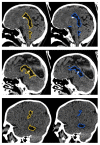Automated Ventricular System Segmentation in Paediatric Patients Treated for Hydrocephalus Using Deep Learning Methods
- PMID: 31360710
- PMCID: PMC6642766
- DOI: 10.1155/2019/3059170
Automated Ventricular System Segmentation in Paediatric Patients Treated for Hydrocephalus Using Deep Learning Methods
Abstract
Hydrocephalus is a common neurological condition that can have traumatic ramifications and can be lethal without treatment. Nowadays, during therapy radiologists have to spend a vast amount of time assessing the volume of cerebrospinal fluid (CSF) by manual segmentation on Computed Tomography (CT) images. Further, some of the segmentations are prone to radiologist bias and high intraobserver variability. To improve this, researchers are exploring methods to automate the process, which would enable faster and more unbiased results. In this study, we propose the application of U-Net convolutional neural network in order to automatically segment CT brain scans for location of CSF. U-Net is a neural network that has proven to be successful for various interdisciplinary segmentation tasks. We optimised training using state of the art methods, including "1cycle" learning rate policy, transfer learning, generalized dice loss function, mixed float precision, self-attention, and data augmentation. Even though the study was performed using a limited amount of data (80 CT images), our experiment has shown near human-level performance. We managed to achieve a 0.917 mean dice score with 0.0352 standard deviation on cross validation across the training data and a 0.9506 mean dice score on a separate test set. To our knowledge, these results are better than any known method for CSF segmentation in hydrocephalic patients, and thus, it is promising for potential practical applications.
Figures





Similar articles
-
Semantic segmentation of cerebrospinal fluid and brain volume with a convolutional neural network in pediatric hydrocephalus-transfer learning from existing algorithms.Acta Neurochir (Wien). 2020 Oct;162(10):2463-2474. doi: 10.1007/s00701-020-04447-x. Epub 2020 Jun 25. Acta Neurochir (Wien). 2020. PMID: 32583085 Free PMC article.
-
Artificial intelligence for automatic cerebral ventricle segmentation and volume calculation: a clinical tool for the evaluation of pediatric hydrocephalus.J Neurosurg Pediatr. 2020 Dec 1;27(2):131-138. doi: 10.3171/2020.6.PEDS20251. Print 2021 Feb 1. J Neurosurg Pediatr. 2020. PMID: 33260138 Free PMC article.
-
Fully automated intracranial ventricle segmentation on CT with 2D regional convolutional neural network to estimate ventricular volume.Int J Comput Assist Radiol Surg. 2019 Nov;14(11):1923-1932. doi: 10.1007/s11548-019-02038-5. Epub 2019 Jul 26. Int J Comput Assist Radiol Surg. 2019. PMID: 31350705
-
Using deep learning convolutional neural networks to automatically perform cerebral aqueduct CSF flow analysis.J Clin Neurosci. 2021 Aug;90:60-67. doi: 10.1016/j.jocn.2021.05.010. Epub 2021 May 24. J Clin Neurosci. 2021. PMID: 34275582
-
VoxResNet: Deep voxelwise residual networks for brain segmentation from 3D MR images.Neuroimage. 2018 Apr 15;170:446-455. doi: 10.1016/j.neuroimage.2017.04.041. Epub 2017 Apr 23. Neuroimage. 2018. PMID: 28445774 Review.
Cited by
-
Automated ventricular segmentation and shunt failure detection using convolutional neural networks.Sci Rep. 2024 Sep 27;14(1):22166. doi: 10.1038/s41598-024-73167-4. Sci Rep. 2024. PMID: 39333724 Free PMC article.
-
Semantic segmentation of cerebrospinal fluid and brain volume with a convolutional neural network in pediatric hydrocephalus-transfer learning from existing algorithms.Acta Neurochir (Wien). 2020 Oct;162(10):2463-2474. doi: 10.1007/s00701-020-04447-x. Epub 2020 Jun 25. Acta Neurochir (Wien). 2020. PMID: 32583085 Free PMC article.
-
Validation of a deep learning model for traumatic brain injury detection and NIRIS grading on non-contrast CT: a multi-reader study with promising results and opportunities for improvement.Neuroradiology. 2023 Nov;65(11):1605-1617. doi: 10.1007/s00234-023-03170-5. Epub 2023 Jun 3. Neuroradiology. 2023. PMID: 37269414
-
Prediction of shunt failure facilitated by rapid and accurate volumetric analysis: a single institution's preliminary experience.Childs Nerv Syst. 2022 Oct;38(10):1907-1912. doi: 10.1007/s00381-022-05552-1. Epub 2022 May 20. Childs Nerv Syst. 2022. PMID: 35595938
-
Hydrocephalus: Ventricular Volume Quantification Using Three-Dimensional Brain CT Data and Semiautomatic Three-Dimensional Threshold-Based Segmentation Approach.Korean J Radiol. 2021 Mar;22(3):435-441. doi: 10.3348/kjr.2020.0671. Epub 2020 Oct 30. Korean J Radiol. 2021. PMID: 33169552 Free PMC article.
References
-
- Fabijańska A., Węgliński T., Zakrzewski K., Nowosławska E. Assessment of hydrocephalus in children based on digital image processing and analysis. International Journal of Applied Mathematics and Computer Science. 2014;24(2):299–312. doi: 10.2478/amcs-2014-0022. - DOI
-
- Srinidhi C L., Aparna P., Rajan J. Recent advancements in retinal vessel segmentation. Journal of Medical Systems. 2017;41:p. 70. - PubMed
-
- de Brebisson A., Montana G. Deep neural networks for anatomical brain segmentation. https://arxiv.org/abs/1502.02445.
MeSH terms
LinkOut - more resources
Full Text Sources
Medical

